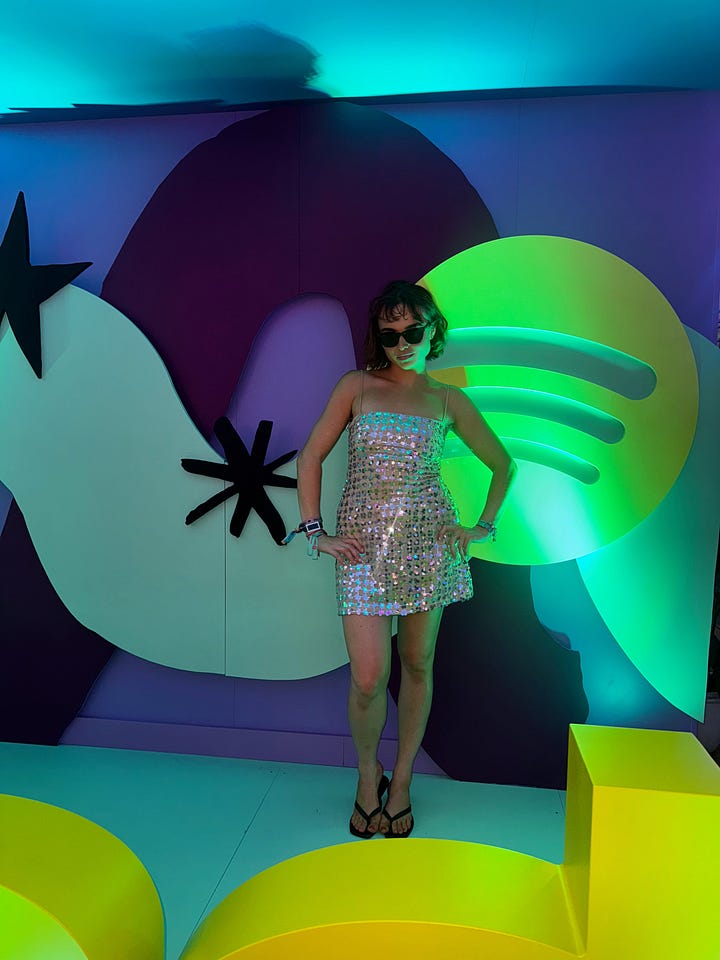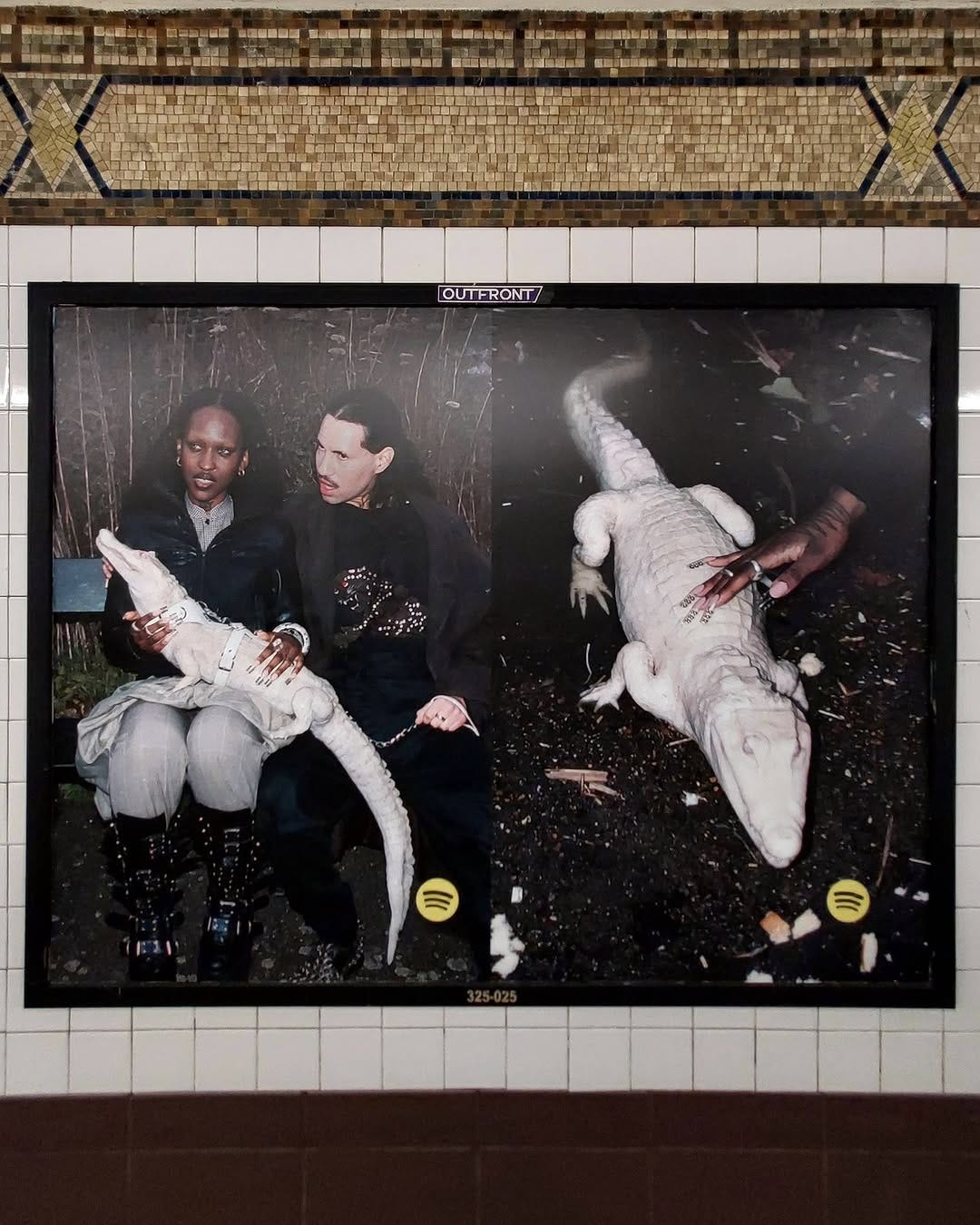"The Best Marketing Isn't Literal": My conversation with Spotify's VP of Marketing & Partnerships, Marc Hazan
What can you learn as a marketer or artist about how to build a fandom from the man who works closely with the biggest artists in the world, as the VP of Marketing & Partnerships at Spotify?
An interview with Marc Hazan, VP of Marketing & Partnerships at Spotify
📍 Recorded live at Spotify Beach, Cannes Lions 2025
In June of every year, the biggest brands, agencies, celebrities, and now top creators, all board flights and migrate to the south-of-France for a week of work and play amongst the who’s who of the branding and creative world. There is nothing like it in the world.
This was my second time at Cannes Lions. As you all know, I am lucky enough to work closely with the Spotify LA team as I attend their events and film episodes of “Middle Row” out of the movie theater located in their LA headquarters.
Attached above is the show I film in Spotify’s movie theater. Watch on Spotify here:
Because of this great relationship, I spent a lot of my time at Cannes Lions this year at Spotify Beach. One of the most talked about activations of the whole week, every year.
During the day, they had panels with artists and podcasters. At one point while I Was there, they had a panel with Miles Caton from the “Sinners” movie where he sang live on the mic. During night time, they had performers like Lola Young and Sombr.


Here is a never before posted clip I got of Lola Young singing “Messy” at Spotify Beach:
My conversation with Marc Hazan, the VP of Marketing and Partnerships at Spotify:
At Cannes Lions 2025, amidst a sea of branded beach lounges and buzzword-saturated panels, Spotify Beach stood out — not just for its energy, but for its vibe. A place where the world's biggest artists, marketers, and executives converge to celebrate culture, not just commerce.
In that spirit, I sat down with Marc Hazan, Spotify’s VP of Marketing & Partnerships, to talk about how the brand has maintained its cool factor while operating at massive global scale. We discussed his unconventional career path, what makes great marketing in 2025, and why Spotify avoids being “literal” in a world obsessed with KPIs.
I am fascinated at Spotify’s ability to remain the cool kid on the block in a world of corporate and sterile branding.
So when I was given the chance to sit down and have a conversation with Marc Hazan, the VP of Marketing & Partnerships at Spotify — I couldn’t say no! In fact, it was one of my favorite parts of the 5-day, packed itinerary of doing panels, brushing shoulders with celebrities and swimming in the Mediterranean Sea.
Nerding out about marketing with one of the best will always be the highlight of my week 😊
Our Conversation:
The transcription has been edited down to get rid of some filler but I kept it as true to the conversation as possible.
C: What is your story? How did you come to be the VP of Marketing
M: I’ve been at Spotify for 14 years now. My relationship with Spotify began even earlier than that — about 17 years ago, when I was at Sony Music. I met Daniel (Ek, the CEO of Spotify) and the team in 2009, when they were about to launch in the U.S. I was responsible for working on the deal that got Spotify and Sony’s content licensed for the U.S. launch.
In 2011, I moved over to Spotify and started in licensing. I went from licensing at Sony to Spotify, and then became responsible for our major label licensing deals. I did that for about 3–4 years, and then that evolved into overseeing partnerships — all sorts of distribution partnerships, like AT&T and Sprint, and with companies around the world.
Spotify & FC Barcelona team up for a special Cactus Jack shirt with Travis Scott (credit: Spotify Newsroom).
Then about 4 years ago, I led the Barcelona partnership, which was a one-of-a-kind sponsorship on paper deal, and from there, we decided to combine the two worlds of partnerships and marketing.
➡️ You can read more about the Spotify x Barcelona collab on the Spotify Newsroom here
M: I now head up that group, which I’ve been doing for about 18 months, and it’s been an amazing journey.
C: Wow, I didn’t realize you had been there that long. Do you think fandom has changed in the streaming era? Has access made fans more or less loyal to artists?
M: I think the connection is as strong as it’s ever been. I think the barrier to connect is lower than ever, which fuels people’s fandom.
M: I’m old enough to remember when I was buying CDs and could only buy one CD a month. I was like, “I hope this is good.”
M: That means that things can go from 0-t-100 really quickly, and with big stars, the journey being hugely accelerated. The boundaries of geography aren’t there anymore. In the past, it was like, ‘Hey, this artist is doing good in the U.K. Let’s ship some CD’s do some promo in Australia and hope it breaks in Australia.’
Whereas now, if a hit goes, it goes globally. The barriers are very, very fluid. The fact that Karol G did 3-nights at the O2 in the U.K. Blackpink are doing Hyde Park or Wimbley Stadium with 90,000 people for 2-nights, I am pretty convinced that fluidity has improved. People are as obsessed as they ever were. Our last campaign was all about celebrating that obsession.
C: “Fanlife”, is that the one you are thinking?
Some Context: Fan Life was a campaign Spotify launched in April of 2025 where they put up posters in major cities. No text, no begging, no call-to-action. All it was was images that hinted at different fandoms. Pink cowboy hats for Chappell Roan. Alligators for Doechii. Stickers for Olivia Rodrigo. It was so brilliant that posters began going missing in major cities as fans tracked them down and tore them off walls for their own keeping.
➡️ You can read more about the fan life campaign on the Spotify newsroom here
M: It was to celebrate the obsession that people have with given artists. Spotify can, in many instances, play an amazing role in forming that connection initially — whether that be us showcasing a song in a playlist or a friend sharing it. All of a sudden, there’s a connection between an artist and a fan that builds and builds — then next thing you know, you’ve got a tattoo of the artist on your hand.
We really wanted to lean in on that and celebrate it.
C: I think the best marketing isn’t literal. I remember being in New York City and thinking about what questions I was going to ask, and I saw one of the posters. I was like, “Okay, that one is Chappell Roan.” You’re not saying, “Hey! This is an ad. We are promoting Chappell Roan on Spotify!”
So what I’m curious about is — how did you choose the artists you wanted to feature?
M: We are deep in the fandoms. We relentlessly obsess about identifying the ultimate fandoms. We have such strong data signals that we can really make sure we connect with the right ones. We were looking at a wide range of talent and obsessions. We put ourselves deep in those communities.
We found fans that were manifesting their obsession in interesting ways.
M: It doesn’t feel like an ad. It feels like a poster a fan would actually have in their room. Funny enough, in New York and London — posters have been ripped off walls.
That’s the ultimate sign this is connecting. If that community gives it a wink, then you’ve landed the punch. They look great. Super proud of them. They landed well with all the communities and fans of given artists.
C: When you were choosing the artists, did you have to find ones that had something visual enough?
M: It was quite easy. People can show their admiration and fandom in different ways. It can be quite subtle.
Like if you look at the Oasis ones — it’s kind of like a jacket and a very nuanced haircut. Everyone would be like, “That’s the Oasis haircut.”
M: There were tattoos and ways fans turn up to shows. Ways they show up at the gym. A lot of it is visual — that’s what outward manifestations look like. Finding the right ones is key.
C: What kind of KPIs or signals are you using to measure the success of a campaign like “Fan Life” beyond just streams?
M: I wouldn’t say we look at streams specifically. It’s more about social chatter. Engagement within the community. Validation from the fans that this is landing — that they understood we understand them.
When you hear people guessing who it is, or taking posters, or photographing and resharing — you know you’ve connected. For us, that’s one of the most powerful signals. Understanding what levels that happens at is key.
And you have to understand, these communities — everyone is so passionate.
C: They are! Sometimes it’s scary. When I’m reporting on it, I’m like, “I don’t want to say anything wrong.”
M: You have the wrong shade of hat or the wrong jacket and you’re going to get found out. Because this is something people deeply care about.
M: There’s no hiding. We had to make sure all the details were emphasized in the right way.
C: Two more questions to tie it up. Spotify is the bridge between artist and fan. Do you ever feel a responsibility to preserve that intimacy, even at scale?
M: We feel responsible to invest in it — which is what we do on the product side, by making it easier for artists to showcase their work. Like with video format or having comments. Different ways for their art to be showcased on our platform.
That is something we religiously do to make sure the connection is there. The two-way access works as it should. We relentlessly focus on that.
Creators are engaging more and more in video. Video is a big focus for us — both in podcasts and on TV. That gives a whole other level of immersion. Gen Z saw a 44% increase in podcast consumption. That’s the medium we’re investing in because that’s where connections are made.
C: Last question, how do you future-proof a brand like Spotify when music and platforms evolve so quickly?
M: We have to move with the times. We have to be totally flexible and give as many creative tools to our artists as possible to help shape our brand and identity.
M: One example is what we call “the bug” (our logo). One big thing we’ve pushed this last year is unlocking “the bug.” For example, in this room, it doesn’t say “Spotify.”

M: For Wrapped last year, we expressed artist vision through “the bug.” All the artists took their own interpretation of it. That’s just one example.
We have to be adaptable. We have to lean in and work closely with talent. What we’ve seen is that when we give talent the platform to create, it doesn’t feel like a marketing campaign — it feels like an extension of their work. They lean in. It feels more authentic. Fans connect. Then the whole thing just keeps going.
M: Also, we’re investing in experiences. We’re constantly evolving to have great new ones on the platform. Wrapped is obviously a key moment.
Making sure we continuously delight, so that creates positive noise and gives objects for our base to engage with — and we’re working closely with creators.
Coco’s TLDR:
Coco’s TLDR:
Marc Hazan is the man spearheading Spotify’s intimacy and coolness in a world that feels increasingly corporate and sterile. The through-line of their campaigns is not to beg people to use the platform — or even to have a call-to-action. Instead, they provide a talking point where the consumer becomes the messenger.
The best marketing isn’t literal.
With Spotify Wrapped, they’re not begging people to keep listening so they can share another Wrapped next year. Instead, they give fans the graphics, tools, and data to celebrate the year they already had. Rather than a call-to-action, it’s a call-to-celebration — rewarding fans for what they’ve already done.
Same goes for the “Fan Life” campaign posters. No call-to-action. Not even the word “Spotify” on them. Just the “bug” tucked into the corner, and a coded message through hats, stickers, tattoos, and haircuts.
When building fandom, think about call-to-celebrations, not call-to-actions.
Here is the full recording for those of you who are audio-first:
Thank you so much for reading, coconuts! 🥥❤️ I hope to see some of you at Cannes Lions in the coming years.












